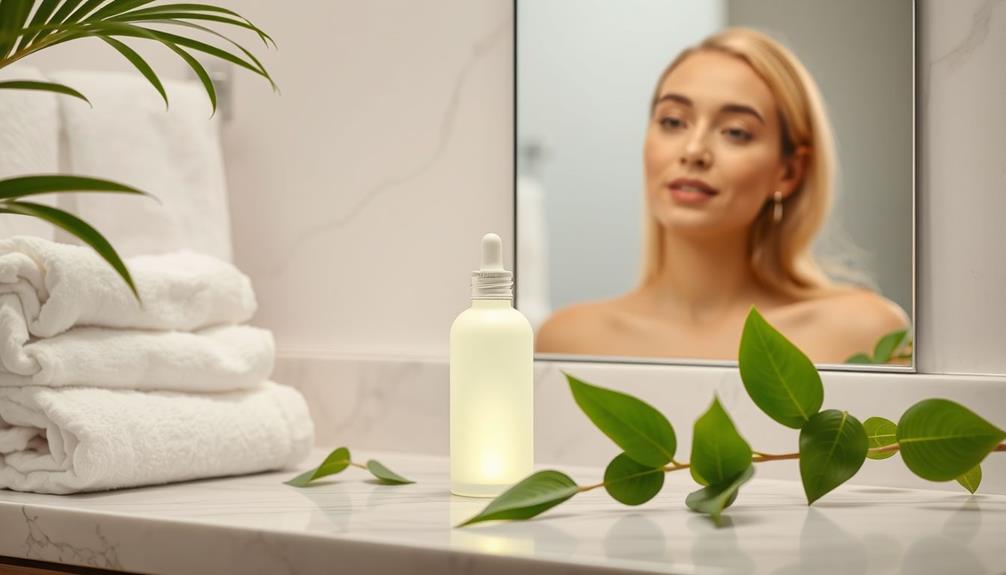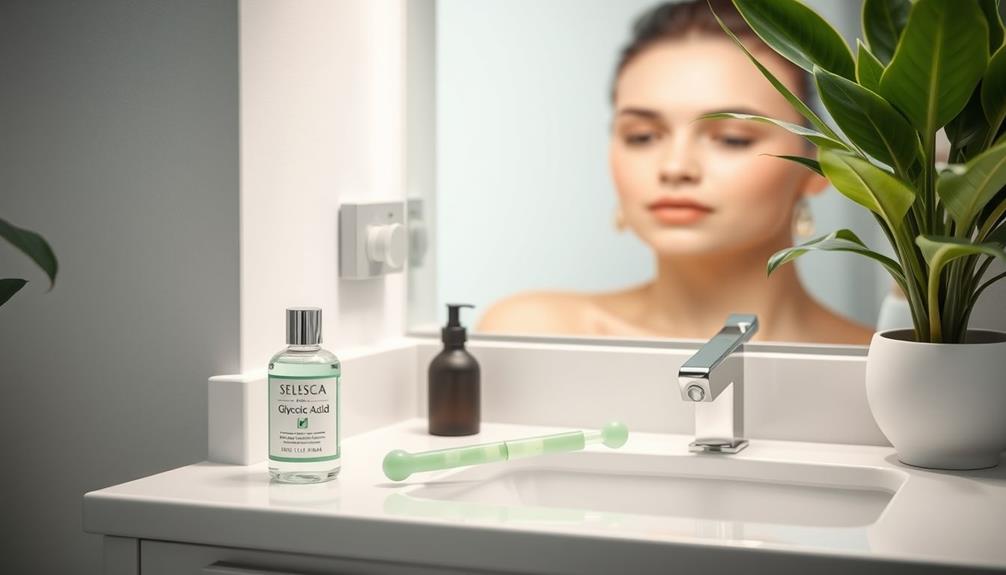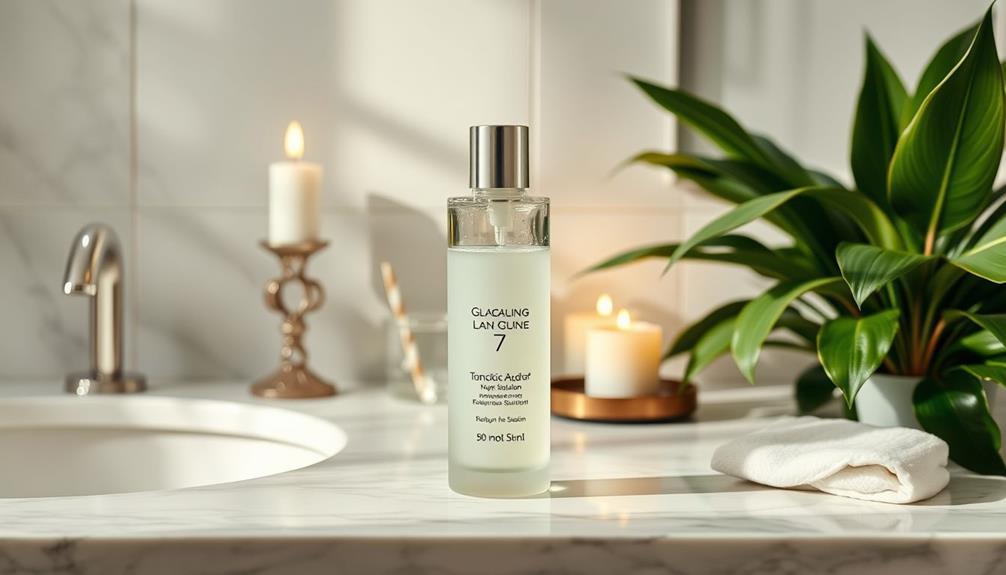Glycolic acid is a game-changer for achieving flawless skin. This potent alpha hydroxy acid helps to exfoliate by eliminating dead skin cells, revealing a smoother and more radiant complexion. It addresses fine lines, dark spots, and acne while also promoting collagen production for tighter skin. By improving the absorption of other products, glycolic acid truly optimizes the effectiveness of your skincare routine. Begin with a lower concentration, such as 5-10%, and gradually increase usage to determine what works best for your skin. Keep reading to discover the benefits and tips on seamlessly incorporating it into your daily regimen.
Key Takeaways
- Glycolic acid is a powerful AHA that exfoliates the skin, promoting a smoother and more radiant complexion.
- It reduces dark spots and hyperpigmentation, leading to a more even skin tone.
- Glycolic acid stimulates collagen production, improving skin firmness and elasticity over time.
- Regular use enhances hydration by attracting moisture, benefiting all skin types.
What Is Glycolic Acid?

Glycolic acid, a powerful alpha hydroxy acid (AHA) derived from sugar cane and fruits, is known for its remarkable ability to exfoliate and rejuvenate your skin.
This water-soluble acid boasts the smallest molecular structure among AHAs, allowing it to penetrate deeper into your skin effectively.
Its exfoliating properties work by loosening the bonds between dead skin cells, enabling their removal and revealing fresher skin underneath.
Additionally, glycolic acid can enhance the absorption of other skincare products, much like how essential oils can promote better skin quality through their therapeutic properties.
If you're dealing with various skin concerns such as fine lines, wrinkles, dark spots, or acne, incorporating glycolic acid into your skincare routine can be a game changer.
Regular use can greatly improve skin texture, giving you a smoother and more radiant complexion.
Typically available in concentrations ranging from 5-10%, you'll find glycolic acid in cleansers, toners, and peels, making it easy to integrate into your regimen.
Key Benefits for Skin

Experience smoother, brighter skin as this powerful exfoliant effectively breaks down the bonds holding dead skin cells together. Glycolic acid's exfoliating properties reveal fresh skin beneath, improving overall skin texture and radiance.
With regular use, you'll notice a significant reduction in dark spots and hyperpigmentation, leading to a more even skin tone. Additionally, incorporating essential oils like lavender or frankincense can further enhance your skincare routine, as they're known for their natural alternatives to chemical products that promote overall skin wellness.
Additionally, glycolic acid stimulates collagen production, which is vital for maintaining skin firmness and elasticity. This means fewer fine lines and wrinkles, giving you a youthful appearance.
Plus, as it acts as a humectant, it attracts moisture to your skin, enhancing hydration and overall skin health.
How Glycolic Acid Works

Glycolic acid works by effectively breaking down the bonds that hold dead skin cells together, making it easier for your skin to shed them.
This exfoliation process not only reveals a smoother complexion but also stimulates collagen production, enhancing your skin's elasticity and firmness.
Incorporating gentle skincare routines, such as yoga for back pain relief, can further complement your efforts for a healthier appearance.
As you incorporate glycolic acid into your routine, you'll notice a reduction in fine lines and an overall improvement in skin texture.
Exfoliation Mechanism Explained
Using a small molecular structure, glycolic acid effectively breaks down the bonds between dead skin cells, making it easier for your skin to shed them and reveal a fresher layer underneath. This process of exfoliation not only improves your skin's texture but also promotes cell turnover, leading to a brighter, more youthful appearance over time.
Here's a quick comparison of glycolic acid's benefits:
| Aspect | Benefits | Effects on Skin |
|---|---|---|
| Exfoliation | Removes dead skin cells | Smoother, clearer complexion |
| Cell Turnover | Increases skin renewal rate | Fades fine lines and wrinkles |
| Skin Absorption | Enhances penetration of skincare products | Improves overall skincare effectiveness |
Regular use of glycolic acid can greatly enhance your skincare routine. By helping to remove dead skin cells, it allows your other skincare products to penetrate more effectively, maximizing their benefits. As a result, you'll notice not just improved texture but also a reduction in fine lines and wrinkles, making glycolic acid a must-have in your quest for flawless skin.
Collagen Stimulation Benefits
Regular application of glycolic acid boosts collagen production, helping your skin become firmer and more elastic. When you use glycolic acid, it penetrates deep into your skin and activates fibroblasts, which are responsible for synthesizing collagen. As a result, you'll notice a significant reduction in the appearance of fine lines and wrinkles over time.
Additionally, incorporating gentle yoga stretches before bedtime can complement your skincare routine by promoting relaxation and reducing stress, which is beneficial for overall skin health gentle yoga stretches.
By promoting cell turnover, glycolic acid also helps to eliminate dead skin cells that can block collagen production, allowing for improved skin regeneration. This process not only enhances your skin texture but also contributes to overall skin health, giving you a more youthful and radiant appearance.
Studies have shown that consistent use of glycolic acid leads to increased levels of both collagen and elastin, vital proteins for maintaining skin elasticity and firmness. With regular application, you can expect long-term improvements in your skin's tone and texture, making it look smoother and more vibrant.
Embracing glycolic acid in your skincare routine is a smart choice for achieving improved skin and maintaining a healthy complexion.
Recommended Usage Guidelines
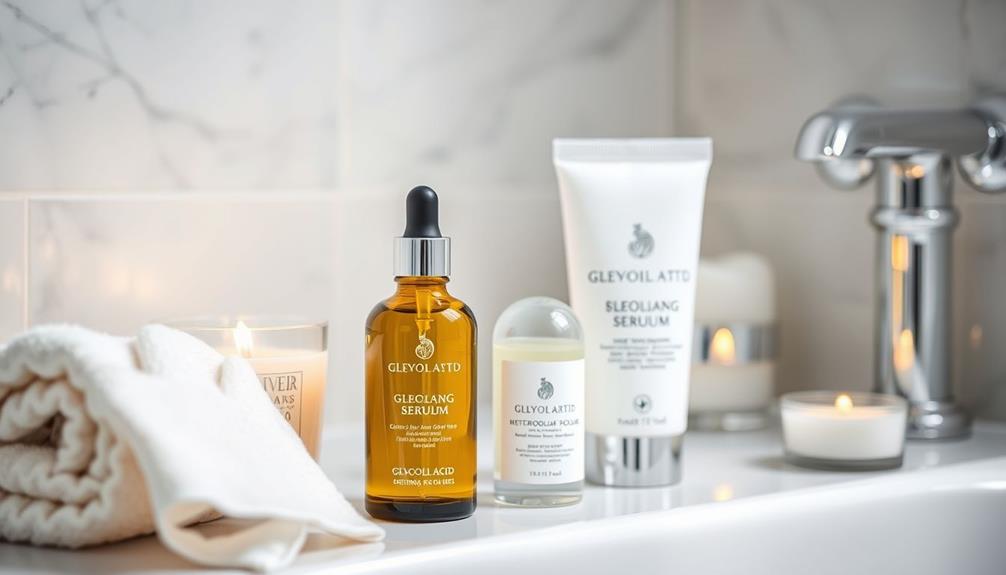
When you start using glycolic acid, it's best to begin with a low concentration of 5-10% to see how your skin reacts.
Many people find that incorporating beneficial ingredients, such as those found in juicing for skin health, can enhance the effects of glycolic acid.
Apply it in the evening on clean skin and use a cotton pad for even coverage, following up with a moisturizer.
Remember to limit your initial use to just a few times a week while your skin adjusts.
Starting With Low Concentration
To achieve the best results with glycolic acid, start with a low concentration of 5-10% to minimize irritation while your skin adjusts. This is especially significant if you have sensitive skin, as higher concentrations can lead to redness or discomfort.
Before diving in, perform a patch test: apply a small amount of the glycolic acid product to a discreet area and wait 24 hours to check for any adverse reactions. Additionally, just as understanding a cat's body language is essential for interpreting its needs, paying attention to how your skin responds to glycolic acid will guide your usage effectively cat health and nutrition.
For beginners, it's best to use glycolic acid products once or twice a week. This allows your skin to gradually increase its tolerance to the active ingredient. As your skin adapts, you can slowly incorporate it into your routine more frequently.
Remember to apply it at night on clean, dry skin and follow up with a hydrating moisturizer to address any dryness.
Lastly, be diligent about sun protection. Glycolic acid can increase your skin's sensitivity to the sun, so applying a broad-spectrum sunscreen during the day is essential. This proactive approach will help you enjoy the benefits of glycolic acid without compromising your skin's health.
Frequency and Application Tips
Applying glycolic acid consistently and correctly is essential to maximizing its benefits while minimizing potential irritation. To get the most out of this powerful chemical exfoliant, follow these recommended usage guidelines:
- Start Slow: Begin with a low concentration of glycolic acid (5-10%) and apply glycolic acid 2-3 times a week. Gradually increase the frequency of use as your skin builds tolerance.
- Evening Application: Always apply glycolic acid products in the evening on clean, dry skin. Use a cotton pad for even distribution across your face and neck, avoiding the eye area.
- Hydration and Protection: Follow up with a good moisturizer to maintain hydration. Since glycolic acid can increase sun sensitivity, it's vital to apply sunscreen daily to protect your skin.
Don't forget to conduct a patch test before full application, especially if you're new to chemical exfoliants or have sensitive skin.
Monitor your skin's response closely; signs of over-exfoliation may mean it's time to reduce the frequency or concentration.
This way, you'll guarantee a smooth and radiant complexion without compromising your skin's health.
Best Products Containing Glycolic Acid

Here are five of the best products containing glycolic acid that can help you achieve flawless skin.
First up, you can't go wrong with The Ordinary Glycolic Acid 7% Toning Solution. This glycolic acid product provides mild exfoliation, enhancing your skin tone and radiance over time.
Next, Pixi Glow Tonic features 5% glycolic acid combined with soothing aloe vera, making it perfect for daily use while promoting a brighter complexion.
If you have sensitive skin, consider Paula's Choice Resist Anti-Aging 5% AHA Exfoliant. Its lower glycolic acid concentration helps improve skin texture without irritation.
For those dealing with dark spots, Sunday Riley Good Genes Glycolic Acid Treatment is an excellent choice. It targets fine lines and dark spots while boosting skin clarity and luminosity.
Lastly, Drunk Elephant T.L.C. Framboos Glycolic Night Serum blends glycolic and salicylic acids for a powerful exfoliating treatment. This overnight solution promotes smoother skin and a youthful appearance.
Incorporating these exfoliating acids into your routine can transform your skin, making it healthier and more radiant.
Potential Side Effects

While glycolic acid can work wonders for your skin, it's important to be aware of potential side effects that may arise during use. As this powerful ingredient exfoliates the skin, you might experience some reactions, especially if your skin is sensitive.
Here are three potential side effects to take into account:
- Skin Sensitivity: Initially, you may notice increased sensitivity, leading to redness or irritation. This should subside as your skin builds tolerance.
- Peeling or Flaking: Higher concentrations of glycolic acid can cause peeling, particularly for those with sensitive skin. Start with lower concentrations to minimize this effect.
- Sun Exposure: Using glycolic acid can heighten your skin's sensitivity to the sun. Daily application of sunscreen is vital to prevent damage.
To avoid adverse reactions, it's important to conduct a patch test before fully incorporating glycolic acid into your routine. This simple step helps assess how your skin reacts and can save you from irritation.
Always listen to your skin and adjust your usage accordingly to enjoy the benefits without the drawbacks.
Glycolic Acid for Different Skin Types
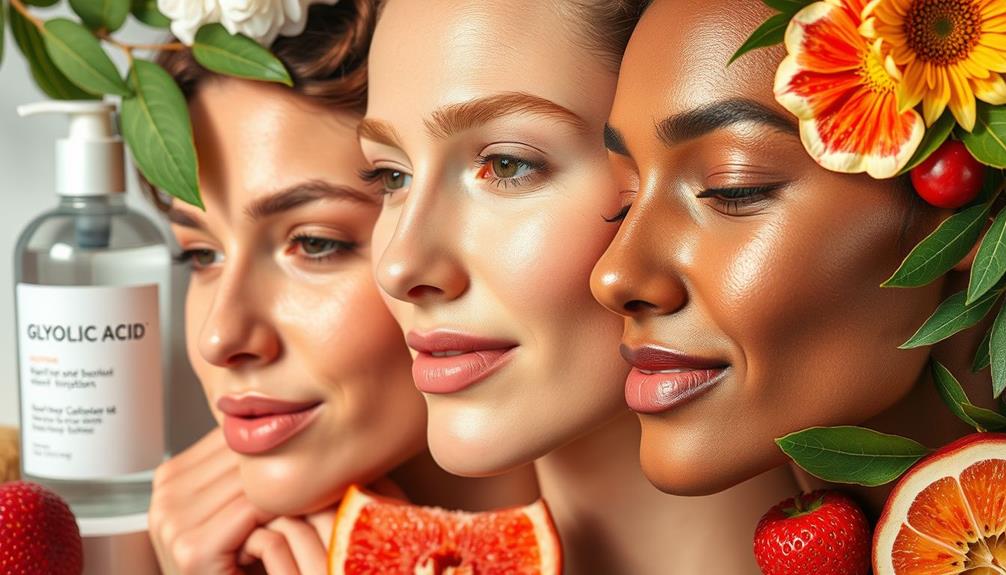
Glycolic acid can be a versatile ally in your skincare routine, effectively catering to various skin types when used appropriately. Here's how different skin types can benefit from its exfoliating properties:
| Skin Type | Benefits of Glycolic Acid |
|---|---|
| Sensitive Skin | Start with lower concentrations (around 5%) to minimize irritation. |
| Oily/Acne-Prone Skin | Unclogs pores, reduces breakouts, and exfoliates dead skin cells. |
| Dry/Dull Skin | Enhances moisture retention for a brighter, more radiant complexion. |
| Combination Skin | Balances oiliness while addressing dry patches for improved texture. |
| All Skin Types | Always conduct patch testing to verify compatibility and avoid reactions. |
Comparing Glycolic Acid to Other Acids

When you compare glycolic acid to other acids, it's important to understand their unique properties.
Glycolic acid, as an AHA, exfoliates the skin's surface, while salicylic acid, a BHA, penetrates deeper to target acne.
Knowing these differences can help you choose the right acid for your skincare needs.
Glycolic Vs. Salicylic Acid
Comparing glycolic and salicylic acid reveals key differences in their benefits and applications for various skin types. While both acids are effective skincare ingredients, they serve distinct purposes. Here's a quick breakdown of their differences:
- Glycolic Acid: This alpha hydroxy acid (AHA) primarily exfoliates the surface of your skin, making it ideal for addressing signs of aging. It improves texture and radiance, helping reduce fine lines and sun damage.
- Salicylic Acid: As a beta hydroxy acid (BHA), salicylic acid penetrates deeper into the pores to target acne-prone skin. It helps unclog pores, reduce inflammation, and prevent future breakouts.
- Usage and Results: Glycolic acid can lead to smoother, brighter skin with consistent use, while salicylic acid promotes clearer skin by treating existing breakouts and controlling oiliness.
Incorporating both acids into your skincare routine can provide extensive benefits. Glycolic acid enhances surface texture, while salicylic acid helps maintain a clearer complexion. Just be cautious about potential irritation when combining these powerful ingredients.
AHA Vs. BHA Differences
Understanding the differences between AHAs and BHAs can help you choose the right acid for your skincare needs.
Glycolic acid is an alpha hydroxy acid (AHA) that's excellent for exfoliating dead skin cells on the surface, making it ideal for improving skin texture and brightness. By using glycolic acid, you can achieve a more radiant complexion while also stimulating collagen production, which helps reduce fine lines and enhances skin elasticity.
On the other hand, salicylic acid, a beta hydroxy acid (BHA), penetrates deeper into the pores, targeting oil and preventing breakouts. This property makes BHAs particularly beneficial for oily and acne-prone skin.
If you have sensitive skin, you should introduce both AHAs and BHAs gradually to avoid irritation. While glycolic acid works wonders for most skin types, its exfoliating effects may be too strong for those with very sensitive skin.
Ultimately, you can use AHAs and BHAs together for a thorough skincare routine, but understanding their unique functions will help you select the one that best suits your skin's needs.
Professional Treatments Available

Glycolic acid treatments offered by professionals can provide more potent results than over-the-counter options, making them an effective choice for enhancing your skin's texture and tone. These treatments usually involve professional chemical peels, which can deliver stronger concentrations of glycolic acid, typically ranging from 30% to 70%. This allows for tailored treatment plans that meet your specific skin needs.
Here are three key benefits of professional glycolic acid treatments:
- Improved Skin Clarity: Regular treatments can help diminish dark spots and uneven skin tone, leading to a more radiant complexion.
- Anti-Aging Benefits: Glycolic acid reduces fine lines and wrinkles, making it a popular choice in anti-aging skincare regimens.
- Comprehensive Post-Treatment Care: Professionals provide essential aftercare recommendations to protect your skin and maintain results, especially important due to increased sensitivity following treatment.
With pre-peel consultations, your skin type and concerns are carefully assessed, minimizing the risk of irritation. By investing in professional glycolic acid treatments, you can achieve noticeable improvements in your skin's appearance and overall health.
Tips for Incorporating Into Routine
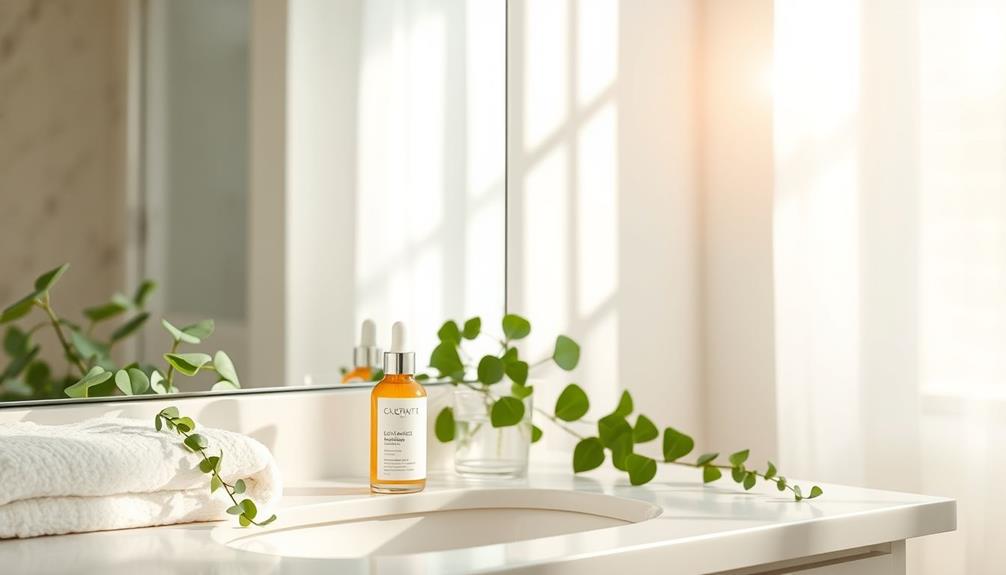
Incorporating glycolic acid into your skincare routine can greatly enhance your skin's texture and clarity, but it is essential to do so thoughtfully. Start with a low concentration of glycolic acid (around 5%) to assess your skin's tolerance. You'll want to gradually increase the frequency to 2-3 times a week, or even daily if your skin is gentle enough.
Before diving in, always perform a patch test to identify any potential irritation or sensitivity, especially if you have sensitive skin. When you're ready to apply glycolic acid products, do so in the evening on clean, dry skin. Follow with a moisturizer to enhance hydration and minimize irritation.
Remember, glycolic acid increases your skin's sensitivity to the sun, so it's important to use sunscreen during the day. Monitor any reactions closely and adjust your usage accordingly. If you notice excessive redness, peeling, or irritation, discontinue use.
Here's a quick reference table to help you:
| Step | Action |
|---|---|
| 1. Start Low | Use 5% concentration |
| 2. Patch Test | Perform before full use |
| 3. Sunscreen | Always apply during day |
Frequently Asked Questions
What Form of Glycolic Acid Is Best?
When choosing the best form of glycolic acid, you'll find toners and serums ideal for daily use, while at-home peels offer a more intensive treatment. Always check for soothing ingredients to minimize irritation.
Which Percentage of Glycolic Acid Is Best?
The best percentage of glycolic acid for you depends on your skin's tolerance. Start with 5% if you're a beginner, and gradually increase to 10%-20% as your skin adjusts for ideal results.
What Is the Perfect Pair for Glycolic Acid?
The perfect pair for glycolic acid is a hydrating moisturizer, like one with hyaluronic acid, and daily sunscreen. This combo helps prevent dryness and protects your skin from UV damage while enhancing your overall skincare routine.
Do Dermatologists Recommend Glycolic Acid?
Think of your skin as a canvas; dermatologists do recommend glycolic acid for its exfoliating magic. They suggest starting slow and using sunscreen, ensuring your journey to radiant skin is both effective and safe.
Conclusion
Incorporating glycolic acid into your skincare routine could be the game-changer you've been searching for.
With its powerful exfoliating properties and ability to reveal radiant skin, why wouldn't you want to give it a try?
Whether you're dealing with dullness, fine lines, or uneven texture, glycolic acid can help you achieve that flawless complexion you desire.
So go ahead, embrace the glow and let your skin shine like never before!

